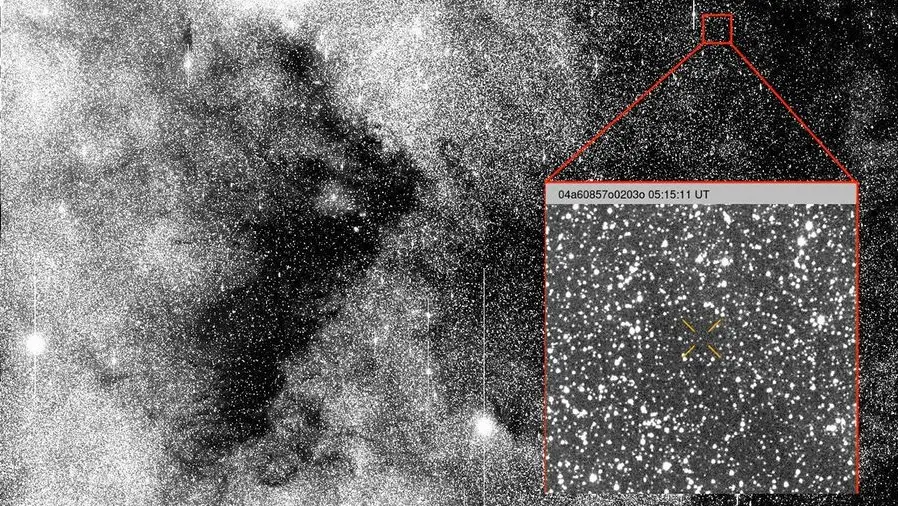Scientists say 3i/Atlas could be a ‘one in a million’ natural object as its speed and colour shift shock observers
-
 This image shows the observation of comet 3I/ATLAS when it was discovered on July 1, 2025. The NASA-funded ATLAS survey telescope in Chile first reported that the comet originated from interstellar space. (Image via science.nasa.gov)
This image shows the observation of comet 3I/ATLAS when it was discovered on July 1, 2025. The NASA-funded ATLAS survey telescope in Chile first reported that the comet originated from interstellar space. (Image via science.nasa.gov)The cosmic enigma known as 3i/Atlas has become one of the most perplexing interstellar visitors ever observed. First discovered in July 2025 by the ATLAS survey telescope in Chile, this icy wanderer has baffled astronomers with its unpredictable behavior, including sudden bursts of speed, a dramatic shift in color, and an unusual network of jets. Scientists now believe that the object, only the third interstellar comet ever detected, might be a “one in a million” find.
Harvard astrophysicist Avi Loeb, known for his controversial ideas about interstellar technology, estimates that 3i/Atlas could have a mass of over 50 billion tons, vastly greater than the famed 1I/ʻOumuamua. And as telescopes capture more data, the mysteries deepen, from an anti-tail jetting toward the Sun to the comet’s unexpected radio signal.
A cosmic anomaly that defies explanation
When images of 3i/Atlas captured by astronomers M. Jäger, G. Rhemann, and E. Prosperi emerged in November 2025, the results stunned the scientific community. The interstellar comet appeared to have at least seven visible jets — some streaming away from the Sun, and others bizarrely pointing toward it. This “anti-tail” defied conventional comet physics.
“Is the network of jets associated with pockets of ice on the surface of a natural nucleus,” Loeb asked in a recent blog post, “or are they coming from a set of jet thrusters used for navigation of a spacecraft?”
That question has reignited the debate about the object’s origin. Most comets release gases as they heat up, forming tails that always point away from the Sun. But 3i/Atlas behaves differently. Not only has it displayed jets that move toward the Sun, but it also changed color dramatically in late October, turning bluer than the Sun itself. The shift was accompanied by a sudden brightening and an unexplained acceleration that couldn’t be accounted for by gravity alone. NASA’s Jet Propulsion Laboratory confirmed that the comet was exhibiting “non-gravitational acceleration,” a telltale sign that something other than the Sun’s gravity was pushing it. Loeb suggests that this could be caused by rapid gas ejection, or something more artificial:
“If the acceleration results from internal engines,” he said, “that might also explain its blue color, which is not typical of dust-rich comets.”
Adding to the mystery, a South African observatory detected the first-ever radio signal from 3i/Atlas on October 24 using the MeerKAT telescope. The absorption lines from hydroxyl radicals confirmed that something active was happening in the comet’s coma, yet no natural explanation fits all the data neatly.
Everything we know about 3I/ATLAS so far
3i/Atlas is only the third interstellar object known to pass through our solar system, following ʻOumuamua in 2017 and 2I/Borisov in 2019. But unlike its predecessors, the object appears massive, complex, and unusually active. Loeb’s calculations suggest its enormous jets are releasing material at a rate of 50 billion tons per month, implying a body at least 10 kilometers wide, far larger than ʻOumuamua’s estimated size of a few hundred meters. Even more extraordinary is its rarity. According to Loeb’s analysis, the odds of an object like 3i/Atlas naturally forming and entering our solar system are “one in a hundred million.” Its retrograde orbit, one that runs opposite to the planets’ general motion, aligns within just 5 degrees of the ecliptic plane, an alignment statistically improbable for random interstellar debris.
NASA and ESA have ruled out any threat to Earth. At its closest approach on December 19, 2025, the object will still be 269 million kilometers away. Unfortunately, its jets are too vast for any current probe to intercept; even NASA’s Juno spacecraft, at its nearest in March 2026, will still be tens of millions of kilometers out of range. Still, telescopes worldwide, including Hubble, Webb, and the Atacama Large Millimeter/submillimeter Array, are watching closely. These upcoming spectroscopic observations may determine whether the jets contain natural cometary gases like carbon monoxide or something else entirely.
Whether natural or technological, this interstellar wanderer is forcing humanity to look at the cosmos with renewed curiosity, wonder, and perhaps, just a hint of suspicion.
TOPICS: 3I/ATLAS
- YouTube removes AI-generated 3I/ATLAS videos impersonating Harvard Professor Avi Loeb
- New analysis presents unusual features documented in the 3I/ATLAS trajectory and activity
- Periodic light variability in interstellar object 3I/ATLAS linked to jet activity
- What we know so far about 3I/ATLAS: Everything understood to date